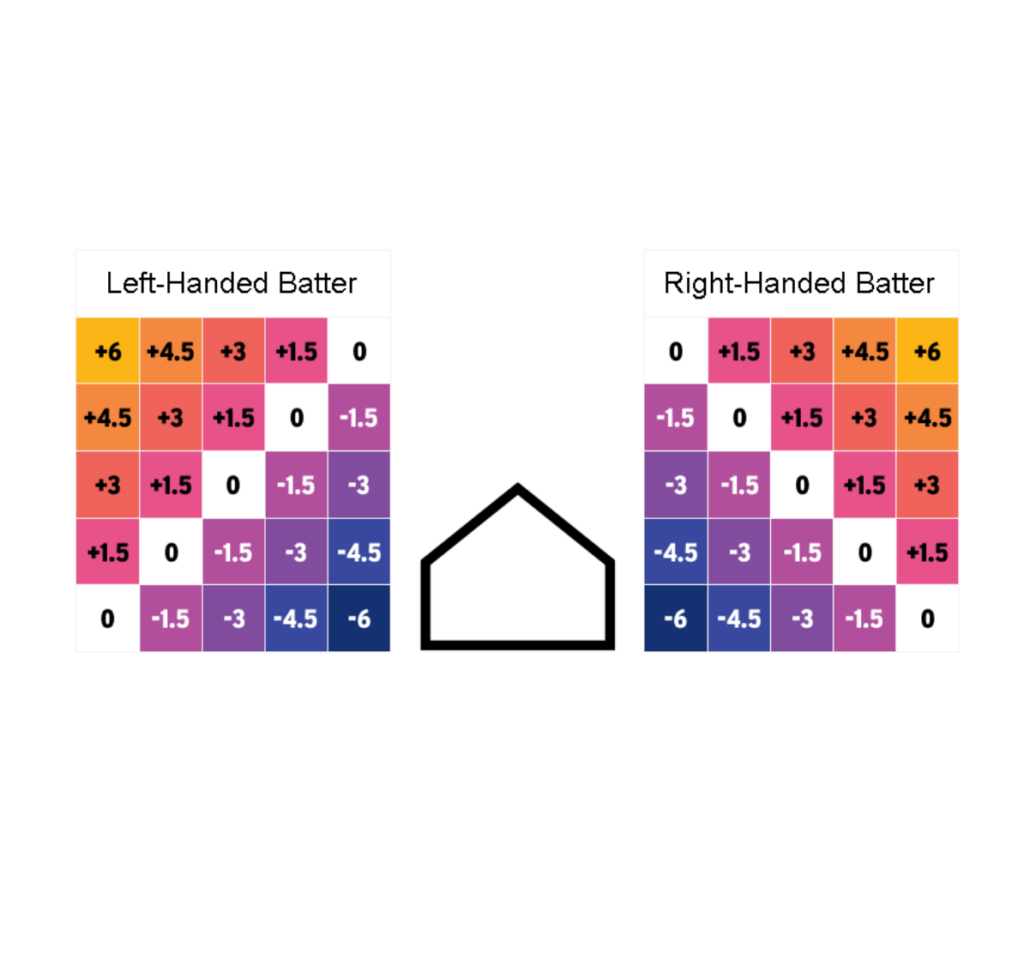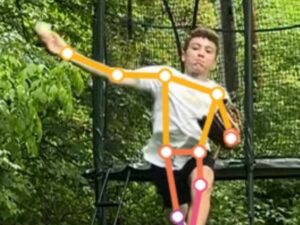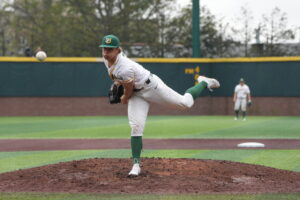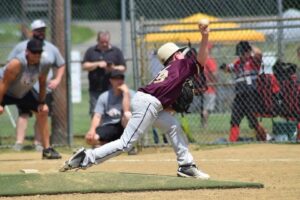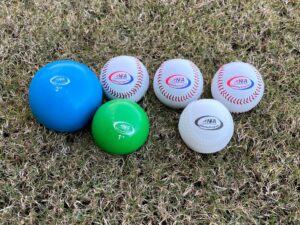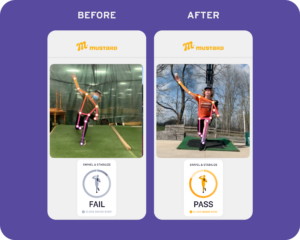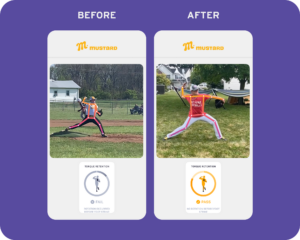By Tom House, PhD, with Lindsay Berra
As much as they’d like to and no matter how hard they try, not every pitcher can throw as hard as Aroldis Chapman. The Yankees reliever routinely tops 100 mph on the radar gun. But, if you take some of that energy you’d use to rear back and throw your hardest and repurpose it into developing a thoughtful pitching strategy that takes effective velocity into account, you can make your best heater LOOK a heck of a lot faster.
WHAT IS REAL VELOCITY?
This is an easy question with an easy answer. Real velocity is the number that appears on the radar gun. By today’s MLB standards, pitch velocity is measured 50 feet from home plate, so very soon after the ball leaves a pitcher’s hand.
WHAT IS PERCEIVED VELOCITY?
Perceived velocity is how fast the pitch appears to the hitter. It factors in the velocity of the pitch and the release point of the pitcher. We know that every one foot of distance is three miles per hour to the batter’s eye. So the longer a pitcher strides, and the closer his release point is to home plate, the faster the pitch will appear to the hitter. Any hitter will tell you there are certain pitchers they face whose pitches just tend to “get on them faster.”
Take Chapman, who strides about as long as anyone in baseball; while the average pitcher strides an average of 87% of his height, Chapman’s stride is seven and a half feet, or 120% of his 6-4 body. When he throws 100 miles per hour with a release point that is 52.5 feet from home plate, the pitch will appear 4.5 miles an hour faster than that of a pitcher striding six feet and throwing 100 miles per hour whose release point is 54 feet from home plate. And while 100 miles per hour is pretty scary, 104.5 is even more terrifying.
Now, look at me. I’m 5-9, but I had a seven-foot stride. That’s why my 83-mph fastball survived in the big leagues for eight years. That extra three miles per hour of perceived velocity I got from striding out an extra foot gave me a slightly below-average big league fastball, and I could work with that.
WHAT IS EFFECTIVE VELOCITY?
Effective velocity is how fast the pitch appears when compared to the pitch that came before it. It also takes into account how far the hitter has to move his bat to make contact; that is, location changes the reaction time of the hitter. A ball thrown inside travels less distance than a ball thrown outside, so the location of the ball in effect adds or subtracts distance from your stride length. By mastering effective velocity, you can make your pitches look better than they are.
An 86-mph fastball straight down the middle looks 86 mph. But if it’s inside, it will appear 92 mph to the hitter’s eyes, and if it’s away, it will appear to be 80 mph. That’s a 12-mph spread, and as a pitcher, you need to live outside that spread to keep hitters from timing your pitches.
Take that 86-mph fastball and throw it down and away again, and it’s going to look like 80 mph. If you have a 74-mph breaking ball and you throw it inside, it looks 80 mph. So the fastball down and away and the breaking ball are exactly the same timing to the batter’s eyes. You don’t want that.
There has never been anyone better than Greg Maddux with effective velocity. Remember Maddux facing Barry Bonds? Bonds looked for anything hard and in, so when Maddux threw the changeup inside, Bonds couldn’t keep it fair. Say that changeup was 74 mph. If it was inside, it would look 80 mph, and if it was away, it would look 68 mph. Follow that with a 90-mph fastball inside, which appears 96 mph, and that’s a 28-mph difference in effective velocity between the two pitches. If a pitch has more than an 18-mph differential from the pitch before, it’s called a “lockout.” Not even Barry Bonds could hit a lockout fastball after a changeup away.
Kyle Hendricks, 89mph Two Seamer and 74mph Curveball, Overlay. pic.twitter.com/CCXPXjx2zf
— Rob Friedman (@PitchingNinja) July 24, 2020
Kyle Hendricks with the Chicago Cubs does this very well. He’s Maddux-like in his mastery of effective velocity. Hendricks has figured out how to make his fastball look 105 miles per hour even though he’s a 93 guy, just by surrounding it with slow and location. Look at the two pitches above. He throws an 89-mph two-seam fastball up and in, which looks 95 mph to the hitter, followed by a 74-mph curveball low and away, which looks 68 mph. That’s a 27-mph window for a total lockout pitch.
WHAT DOES THIS LOOK LIKE FROM THE HITTER’S PERSPECTIVE?
When the ball comes out of the pitcher’s hand, the hitter has to first recognize whether it’s a fastball, a breaking ball or a changeup. Then, he has to decide whether or not to swing, and if he decides to swing, he has to predict where the ball will go. The timing of that will be different with every pitcher and every hitter, and if a pitcher is good at managing his effective velocity, the timing of the hitter will be unpredictable because it will be different on every pitch. The pitcher has the advantage because the hitter is constantly having to adjust. Pitching is a purpose, but hitting is a guess.
Obviously, some guys guess better than others. Bat speed is the absolute velocity of the swing, and it’s determined by genetics. Average bat speed for a big-leaguer is around 92 mph. But bat quickness is determined by how quickly a hitter can get his front foot down and get his bat into the hitting zone. Guys who don’t have great bat speed have to come up with bat quickness to be good hitters. Take Don Mattingly, who was a great hitter with below-average bat velocity who made up for it with an incredibly quick bat. If you have both bat speed and bat quickness, you are usually a very good hitter because you can adjust to any location and any speed of pitch.
KNOW YOUR PATH
Every hitter has a bat parabola, or bat path. Every pitcher has a pitch path. When you hear that hitter matches up well against a pitcher, it usually means that his bat path and the pitcher’s pitch path are similar, so the bat naturally gets in the way of the ball more often. There were guys I could not get out in the big leagues, because their bat path and my pitch path were perfectly matched. When you run into that kind of hitter, your only hope is effective velocity. Change location and speed, and don’t throw the same pitch twice. In my day, it showed up in a smaller sample size than you think; you’d make a great pitch and the guy would rake it, and you’d make a crappy pitch and he’d rake that one too, and you’d know. But today, with analytics, they can tell pretty quickly just based on the arcs of the swings and the pitches.
Elite hitters are so aware of where the head of the bat is that they can adjust to any pitch path. In my day, Rod Carew was the best. When he faced an overhand, hard thrower like Nolan Ryan, his bat was upright in his stance. When he faced someone like me, whose ball moved more east to west, he laid his bat down flat. Not everyone has that kind of awareness, but elite hitters are able to recognize, decide and predict better than the others.
Founder Tom House on Effective Velocity.#BeACutAbove #TeamMSTRD pic.twitter.com/H6gUYFGXWr
— Mustard (@TeamMSTRD) November 9, 2020
PITCHING BACKWARDS
Everyone expects a pitcher to throw fastballs when he needs a strike in a 3-1, 3-2 or 2-1 count and offspeed pitches when he’s ahead at 0-1, 0-2 or 1-2. So, throw offspeed in fastball counts and fastballs in offspeed counts.
When I pitched, I knew I didn’t have a good fastball, so I threw slow, slower, slow, fastball, where a guy with a good fastball would throw fastball, fastball, slow. In my generation, we called this “pitching backwards.”
Today, the ratio of hard to soft is predetermined based on each pitcher’s command and his out pitches. Athletes are throwing harder than they’ve ever thrown, but interestingly, they throw fewer fastballs than ever relative to the percentage of pitches they throw. In my generation, we threw 60 to 65 percent fastballs fb, 20 to 25 percent breaking balls and 15 to 20 percent changeups. Today, they throw around 40 percent fastballs and 20 percent each of curveballs, sliders and changeups. Even though athletes throw harder, the offspeed pitches get people out better. They realize now how mastery of effective velocity will turn an average pitcher into an above-average pitcher and an above-average pitcher into a star.
If you’d like more great content from Mustard, and you’d like to evaluate and improve your own pitching mechanics, download the Mustard pitching app today.

